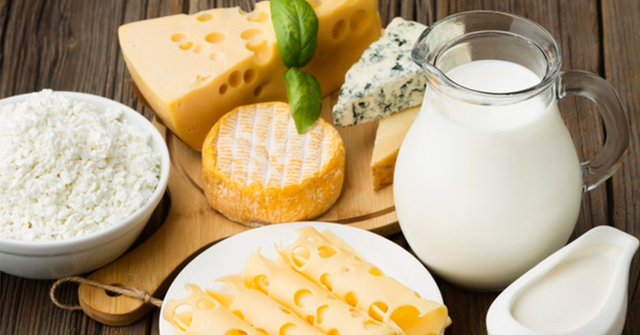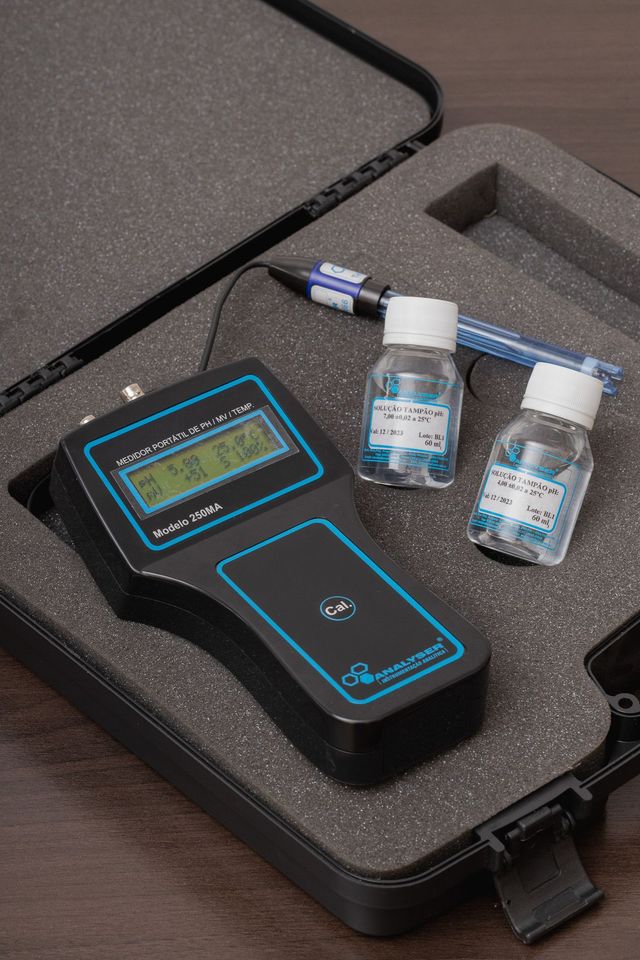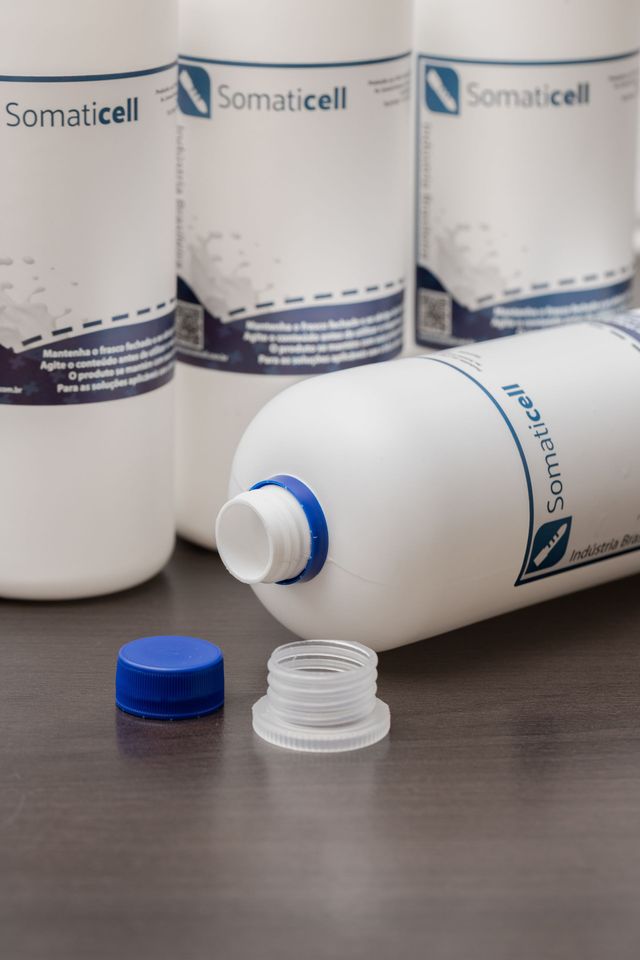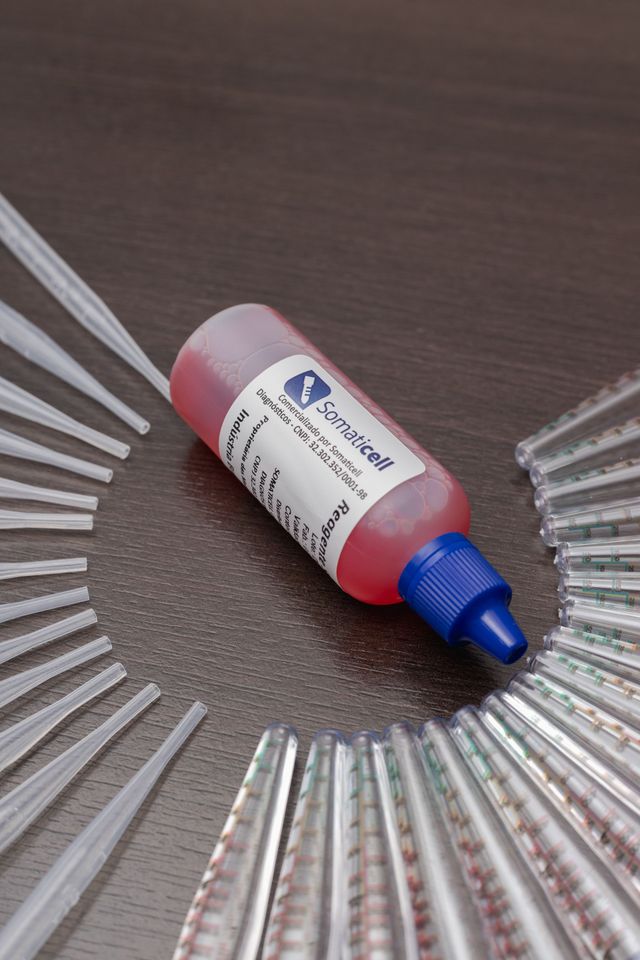Bitterness in cheeses: understand why this happens
No time to read? Listen to the narration of this article in Portuguese:
This technological defect during the cheese making process is due to many factors.
The production and consumption of cheese dates back to very ancient times. There are reports that the consumption of solidified milk dates back to 7.000 years BC and archaeological findings reveal the existence of cheeses made from cow and goat milk 6.000 years BC
However, experts consider the Middle Ages as the initial milestone of its manufacture. There is no doubt that cheese is one of the most consumed products in the world, given its versatility for use in the kitchen.
Not only that, the cheese has several types that please the most diverse palates. And speaking of taste, we come to the main theme of the article: The bitterness of cheeses.
Each person has a power of perception on this aspect. In this sense, the threshold of perception of bitter taste varies greatly between individuals. Still, human beings have a natural tendency to reject bitterness; this is an innate form of protection, as most poisons are bitter.
There are many reasons why cheese reaches bitterness levels above what is acceptable to consumers. And that's a shame. The formation of a bitter taste is one of the most complex problems that can arise during the ripening or storage of cheeses. This complexity is due to the variety of factors that can cause or influence the intensity of this defect.
Were you curious and want to better understand what these factors are? Continue reading and discover tips to overcome this problem. Follow with us!
Why do cheeses taste bitter?
It is considered a defect of technological origin the formation of bitter taste in cheeses.
Thus, there may be rejection of the product by the consumer, thus causing damage to the cheese industry.
The peptides resulting from the hydrolysis of milk proteins are the main causes of cheese bitterness.
Furthermore, this process occurs due to the presence of enzymes formed by lactic bacteria and NSLAB (non-starter lactic-acid bacteria), endogenous milk enzymes, somatic cell proteases or even by the residual action of rennet.
Under normal conditions, these bitter peptides are naturally degraded into non-bitter molecules during cheese ripening.
However, the excessive accumulation of bitter compounds may indicate disordered proteolysis, which unbalances the formation and degradation balance of these peptides.
The causes of cheese bitterness
During the manufacture of cheese, it is necessary to be aware of factors that can lead to the formation of low molecular weight peptides responsible for bitterness, such as:
- Milk quality;
- Quantity and quality of ingredients.
See each of these topics in detail:
1. Milk quality
It is possible to consider the quality of the milk as the main source of cheese defects. Not just the bitterness.
In this regard, the milk quality points that can generate bitterness in the cheese are as follows:
Total Bacterial Count (TBC)
A contagem microbiana geralmente é feita a partir de métodos de contagem de microrganismos mesófilos (organismos que se desenvolvem melhor em condições de temperatura moderada, entre os 20 e os 45 °C).
However, psychotrophic organisms (microorganisms capable of multiplying at refrigeration temperature) are strongly proteolytic, and their enzymes remain in milk even after pasteurization. Thus, milk stored for long periods under refrigeration has a predominantly psychrotrophic microbiota.
Thus, large amounts of proteases and lipases are produced, which in turn will degrade cheese components during maturation.
Considering that this degradation causes cheese bitterness, the effect of these enzymes is more noticeable in cheeses with a long maturation period. This is because enzymatic degradation occurs slowly. Remembering that the current standard determines a maximum count of these microorganisms is 300.000 CFU/mL.
Somatic Cell Count (SCC)
O leite com alta CCS (com a contagem acima de 400.000cél./mL) apresenta elevados teores de plasmina. É certo que essa enzima é uma protease que hidrolisa a caseína, levando à formação de sabores amargos nos produtos lácteos.
Furthermore, the action of plasmin and the proteases produced by psychotrophs is very similar. Thus, it is difficult to differentiate by analytical methods the action of each one of them in the cheeses, being both undesirable and that should be avoided.
Antibiotic Residues
Os antibióticos ministrados para o rebanho também têm a capacidade de causar amargor nos queijos. A principal fonte de Antibiotic Residues em leite origina-se do manejo incorreto de drogas no controle da mastite ou de outras doenças infecciosas.
The residues of these medicines reduce or nullify the action of the yeast. Thus, it is possible to generate a deficient acidification, which compromises the physicochemical composition of the cheese, as well as its sensory characteristics.
Also, antibiotic residues in milk for cheese manufacturing inhibit the lactic acid bacteria present in raw milk and in the drip (starting culture), altering the entire fermentation process.
Physical-chemical composition
Cheese is made up of proteins, lipids, carbohydrates, mineral salts, calcium, phosphorus and vitamins. In this sense, the fat content of milk has the power to interfere with the perception of bitterness.
Bitter peptides are hydrophobic and tend to dissolve in fat, which has a non-polar character, which minimizes their sensory perception. For this reason, cheeses such as Saint-Paulin, which is produced with semi-cooked mass and is low in fat, have a greater tendency to become bitter.
Also, milk with high acidity implies a greater retention of rennet in the curd. Consequently, unbalanced proteolysis is generated during cheese ripening.
2. Quality and quantity of ingredients
The ingredients can also interfere with the bitterness of the cheese. This is because their quality and quantity have the power to impact the final product.
Therefore, in the production of your cheese pay attention to the following items:
Rennet
Cheese is produced by curdling milk. Thus, rennet is one of the most important ingredients for the constitution of the physical characteristic of cheese.
However, the use of an incorrect dose of rennet or inadequate coagulant can also cause bitter taste in cheeses.
Thus, with excess addition, the residual effect of the enzyme will cause the accumulation of bitter peptides.
It is worth remembering that the use of low-specificity coagulants and heat-resistant coagulants are not recommended for cheeses with medium or long maturation.
Ferments
Yeast microorganisms play an important role in reducing bitter taste, as they are responsible for secondary proteolysis, which degrades peptides into amino acids. In contrast, yeasts with low activity present a mismatch in this degradation, providing the accumulation of bitter peptides.
Not only that, some strains may have strong proteolytic activity on casein.
In this sense, there is a need to choose the most suitable yeast for each type of cheese being produced.
Salt
Low salt directly interferes with changes in the tertiary structure of casein, resulting from the imbalance in the hydrophobic bonds of the chains. In this scenario, b-casein is denatured and can be more easily degraded, releasing the bitter peptides. It is due to this condition that it is difficult to reduce the salt content in cheeses without compromising their sensorial quality.
Additions
The additives present in cheese production also have the power to interfere with the sensorial aspects of the final product. Calcium chloride is used when milk is pasteurized to improve coagulation efficiency and increase yield. The second most used additive is nitrate. This function is to inhibit the development of bacteria of the clostridium genus.
Thus, to avoid bitterness in the cheese, even using these additives, it is necessary to respect the maximum recommended dosage of these ingredients.
Production solutions to avoid cheese bitterness
Despite the occurrence of several factors that contribute to the bitterness of cheese, it is possible to control this undesirable event. This is because you must monitor the stages of the manufacturing process.
In this way, the occurrence of technological defects in cheeses is minimized, especially the excessive accumulation of bitter compounds. Follow the solutions to avoid losses in your cheese production:
Pasteurization temperature control
The first point of attention in the manufacturing process is the pasteurization temperature.
It is true that temperatures above 75°C promote the denaturation of whey proteins that are retained in the curd. In this sense, the coagulation time and retention of more chymosin in the mass are increased. Therefore, knowing that these proteins have a high water retention capacity, the cheeses now have a higher moisture content. In this way, the bitterness formation processes are favored.
Dough cooking temperature
The cooking temperature used in the manufacture of cheeses must be monitored according to the type:
- Hard cheeses (50 to 55 °C)
- Semi-cooked cheeses (36 to 38 °C)
Due to the processing temperature of semi-cooked cheeses being below the rennet denaturation temperature (around 52 °C), their proteolytic activity is maintained during maturation. Therefore, semi-cooked cheeses such as Prato, Gouda, Saint-Paulin and Minas have a greater tendency to be bitter, when compared to hard cheeses, such as Grana (Parmesan) and Swiss cheeses.
Maturation
The maturation of cheeses is carried out, in most cases, in chambers with temperature and humidity control. The time varies according to the type, and can range from a few weeks to many months.
In general, the maturation index is measured by the degradation of casein, through the evaluation of the proportion between total nitrogen and soluble nitrogen.
To control the bitterness of the cheese, it is necessary to pay attention to the cheese ripening temperature.
This is because temperatures above 14-15°C or below 7-8°C can stimulate the proteolytic activity of rennet enzymes.
Furthermore, unregulated temperature can inhibit the peptidolytic (proteolytic) activity of bacterial enzymes.
Control of surface contamination
Even after an optimized process to prevent cheese bitterness, it is necessary to stick to the storage process as well. Due to the fact that unwanted molds and/or yeasts that develop on the cheese rind can produce proteases that migrate into the product, decomposing the casein and causing changes in taste.
Furthermore, contamination can come from the brine or from the maturation and packaging environment itself.
Therefore, it is of paramount importance that the cleaning of production and maturation facilities is carried out frequently.
Herd feeding control
Herd feeding can influence the formation of strange tastes in cheese, including bitterness.
However, the intensity of this factor is generally mitigated by mixing milk from different sources at the factory reception. Even so, it is important to extensively eliminate all factors that may interfere with the sensorial and physical quality of the cheese.
Final considerations
After analyzing all the possible causes of cheese bitterness, it is necessary to consider that some categories of cheese are more likely to present bitterness, mainly aged cheeses with raw and semi-cooked dough and with low salt content.
Also, cheeses with white fungus such as Brie and Camembert also tend to have a bitter taste, due to the proteolytic activity of Penicillium camemberti.
Outros tipos de queijos que também estão predispostos a amargar são os processados a baixas temperaturas e com pH mais baixo. Isso porque estes têm maior predisposição a formar peptídeos amargos durante a maturação.
In this sense, taking all these factors into account, it can be concluded that preventing the formation of a bitter taste in cheese involves controlling all stages of production, starting with the careful selection of raw materials, quality control and quantity of ingredients. used.
In this way, it is possible to minimize the possibility of the appearance of defects such as bitterness, or any other defect that compromises the desired characteristics of the product.
Gostou do conteúdo? Saiba que disponibilizamos muito mais para você! Acesse os artigos do nosso blog e fique por dentro das informações mais relevantes sobre como manter a qualidade do leite produzido pelo seu rebanho e muito mais!
Conheça as
nossas soluções para a saúde do seu rebanho! Com elas sua cadeia produtiva de leite nunca mais será a mesma.
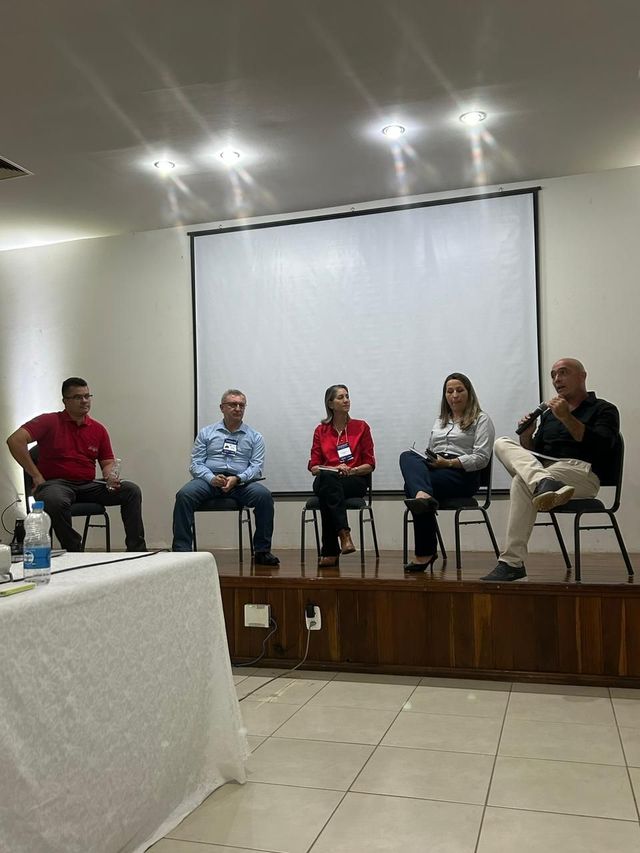
Discover our App
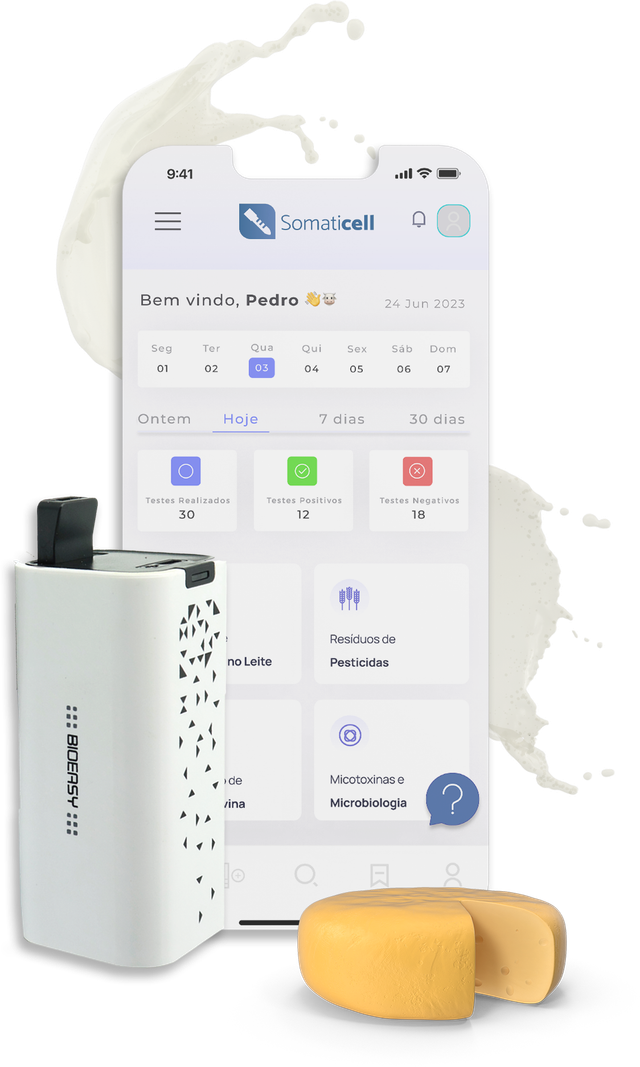
Our Educational Videos
Somaticell on Social Networks


